Single Mode vs Multimode Fiber Cable
With the advent of fiber optic networks, our world has entered a new era of communications. Many decisions come into play when installing fiber optic cabling. What are the different sizes of fiber-optic cable? What is the common size for multimode fiber? How thick is 1 mm optical fiber? Let's read this article with those questions in mind.
By far, one of the most important questions is whether to install single mode or multimode. This decision has huge implications for your network’s distance, bandwidth, and budget, It is, therefore, crucial to understand the differences between these two types of fibers. This article explains the differences between Multi-mode and Single-mode fiber and the maximum distance you can expect for different data rates from 100Mb to 40GbE on OM1, OM2, OM3, OM4, and OS1 fiber types.
what is Multimode fiber?
Multimode fiber can carry multiple light rays (modes) at the same time by having varying optical properties at the core; essentially light traveling the shortest path (down the middle) travels the slowest. The larger core simplifies connections and takes advantage of the lower-cost LED & VCSEL technologies which operate in the 850nm window. Due to dispersion, the range is limited so it tends to be used as premises cabling when less than a kilometer. It comes in two core sizes, 62.5 and 50 microns.
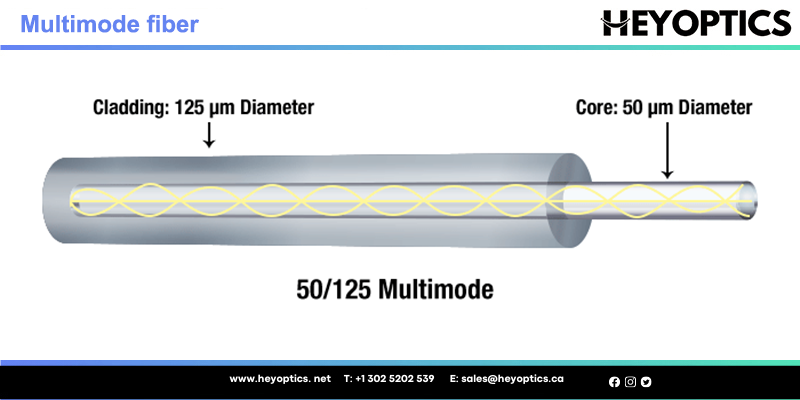
what is Singlemode fiber?
Singlemode fiber has a much smaller core size of 9 microns and has a single light path and can travel much longer distances of up to 100km. These require more expensive electronics which operate in the 1310 and 1550nm windows and are typically used in long distance LAN’s, Cable TV, and telephony applications.
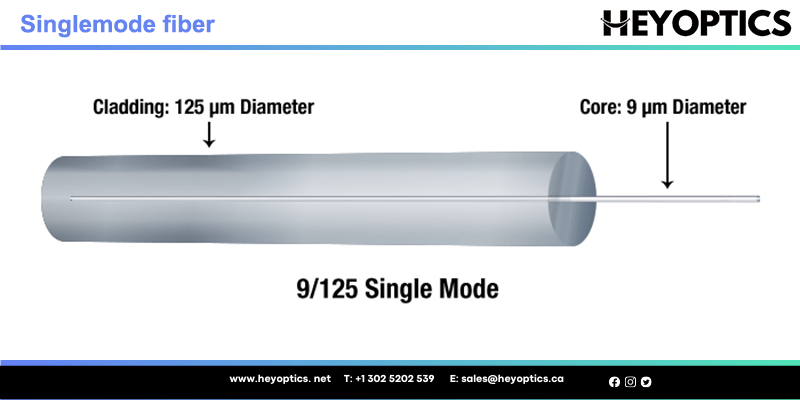
Overview of SingleMode vs Multimode Fiber Optic Cable
Types of fiber-optic cables
Optical fibers carry light signals down them in what are called modes. That sounds technical but it just means different ways of traveling: a mode is simply the path that a light beam follows down the fiber. One mode is to go straight down the middle of the fiber. Another is to bounce down the fiber at a shallow angle. Other modes involve bouncing down the fiber at other angles, more or less steep.
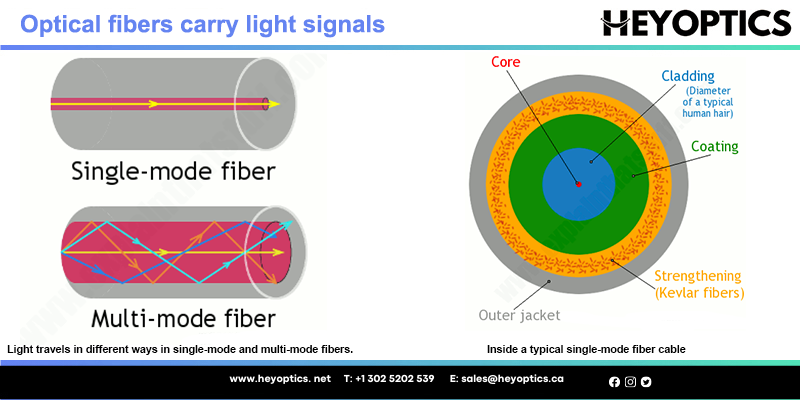
Core Diameter
Single mode fiber core diameter is much smaller than multimode fiber. Its typical core diameter is 9 µm even if there are others available. And multimode fiber core diameter is 50 µm and 62.5 µm typically, which enables it to have a higher "light-gathering" ability and simplify connections. The cladding diameter of single mode and multimode fiber is 125 µm.
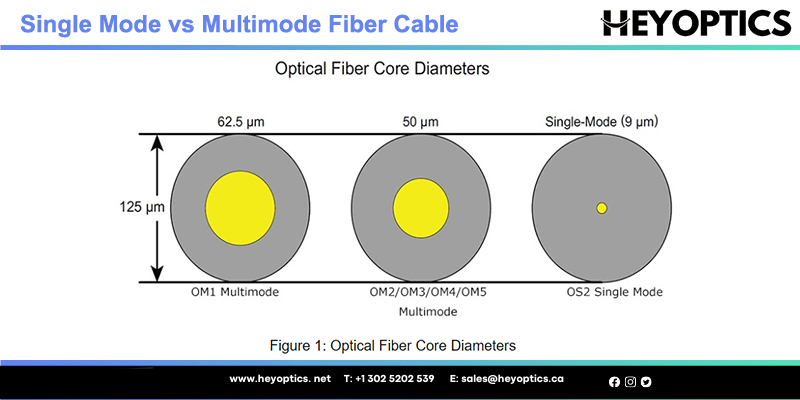
The attenuation of multimode fiber is higher than SM fiber because of its larger core diameter. The fiber core of a single mode cable is very narrow, so the light that passes through these fiber optic cables is not reflected too many times, which keeps the attenuation to a minimum.
| 9/125 Single Mode Fiber Simplex | 50/125 OM3 Multimode Fiber | ||
| Attenuation at 1310nm | 0.36 dB/km | Attenuation at 850 nm | 3.0 dB/km |
| Attenuation at 1550nm | 0.22 dB/km | Attenuation at 1300 nm | 1.0 dB/km |
Fibre Optic Cable Transmission Distances
These are the industry standard minimum distances achieved with each fiber type, however, some cable manufacturers offer enhanced cables that exceed these. It’s always best to check the manufacturer's specification.
The table below shows distances for ratified standards only.
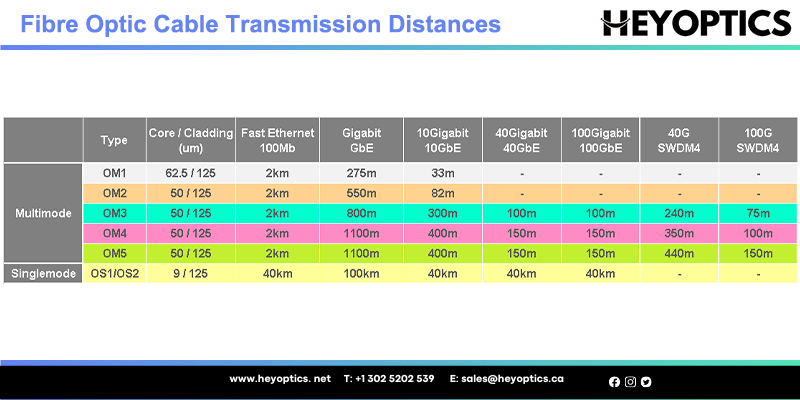
System Cost
To utilize the fundamental attributes of single mode fibers, which are generally geared towards longer distance applications, requires transceivers with lasers that operate at longer wavelengths with smaller spot-size and generally narrower spectral width. These transceiver characteristics combined with the need for higher-precision alignment and tighter connector tolerances to smaller core diameters result in significantly higher transceiver costs and overall higher interconnect costs for single mode fiber interconnects.
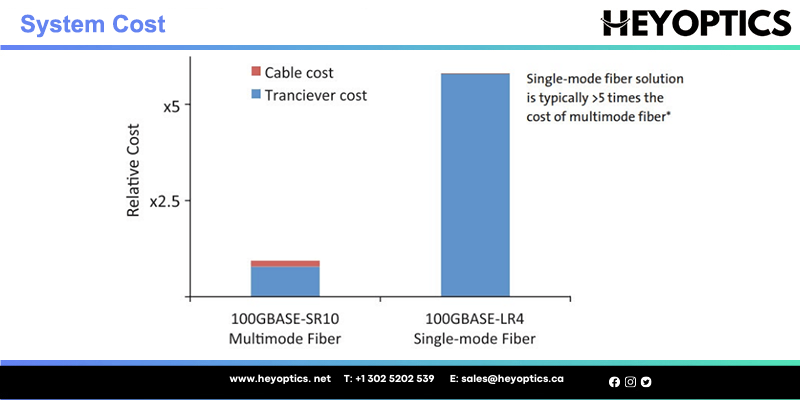
Fabrication methods for VCSEL-based transceivers that are optimized for use with multimode fibers are more easily manufactured into array devices and are lower cost than equivalent single-mode transceivers. Despite the use of multiple fiber lanes and multi-transceivers arrays, there are significant cost savings over single-mode technology employing single or multichannel operation over simplex-duplex connectivity. Multimode fiber system offers the lowest system cost and upgrades path to 100G for standard-based premises applications using parallel-optic based interconnects.
Installation Cost
Single-mode optical fiber often costs less than multimode fiber. When building a 1G fiber-optic network that you want to be able to go to 10G or faster eventually, the savings on the cost of fiber for single-mode saves about half-price. While the multimode OM3 or OM4 fiber increases 35% in cost for SFP modules. The single-mode optics are more expensive, but the labor costs of replacing the multimode are significantly higher, especially if that follows OM1—OM2—OM3—OM4. If you are willing to look at used ex-Fibre Channel SFPs, the price of single-mode 1G drops through the floor. If you have the budget and need 10G short connections, the economics at last check still support multimode. Keep an eye on those economics though, as history suggests that the price premium for single-mode will drop.
FAQ about Single Mode vs Multimode Fiber Optic Cable
What is a better single mode or multimode fiber type?
As has been mentioned above, single mode fiber and multimode fiber cable have their advantages on cost and applications. There is no such thing that single mode optical fibers are better than multimode ones. Just choosing the best-fit one for your applications is ok.
Can I mix single mode and multimode fiber types?
This answer to this question is “no”. Multimode fiber and single mode fiber have different core sizes, and the number of light modes that they transmit is also different. If you mix the two fibers or connect them directly, you’ll lose a large amount of optical loss, resulting in a link flapping or being down. Keep in mind that never mix different types of cabling randomly.
Can I use a multimode transceiver on a single mode fiber optic cable?
Generally speaking, the answer is "no". The large optical loss will occur if a multimode transceiver is connected with a single mode fiber. However, the opposite will work. For example, 1000BASE-LX single mode SFP can work on multimode fiber cable by using mode conditioning fiber cable. Sometimes, fiber media converters also can be used to solve such problems between single mode transceivers and multimode transceivers.
Single mode vs multimode fiber optic cable type: which should I choose?
When deciding between single mode and multimode fiber cables, the first factor to consider is the fiber distance that you need actually. For example, in a data center, multimode fiber cables are enough for a distance of 300-400 meters. While in applications that require distances up to several thousands of meters, the single mode fiber is the best choice. And in applications that can use single mode and multimode fiber, other factors like cost and future upgrade requirements should be taken into consideration for your choice.
Conclusion
From the comparison of single-mode and multi-mode fiber optic cables, it can be concluded that single-mode fiber optic cabling systems are suitable for long-distance data transmission applications and are widely used in carrier networks, metropolitan area networks, and passive optical networks. Multimode fiber optic cabling systems have shorter distances and are widely deployed in enterprises, data centers, and local area networks.
No matter which one you choose, choosing the one that best suits your network needs, based on total fiber cost, is an important task for every network designer. Heyoptics offers all types of fibers including OM1, OM2, OM3, OM4, OM5, and OS1 fibers to name a few. If you need to buy a 1mm fiber optic cable or to know more, please contact sales@heyoptics.ca.



